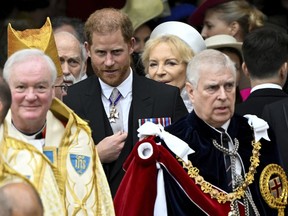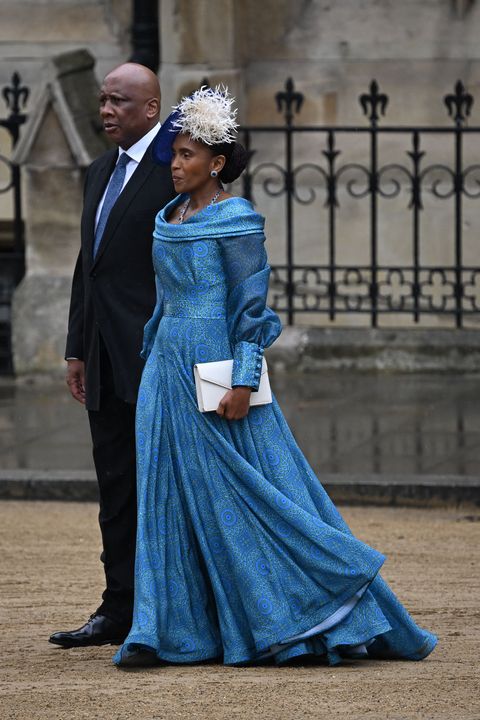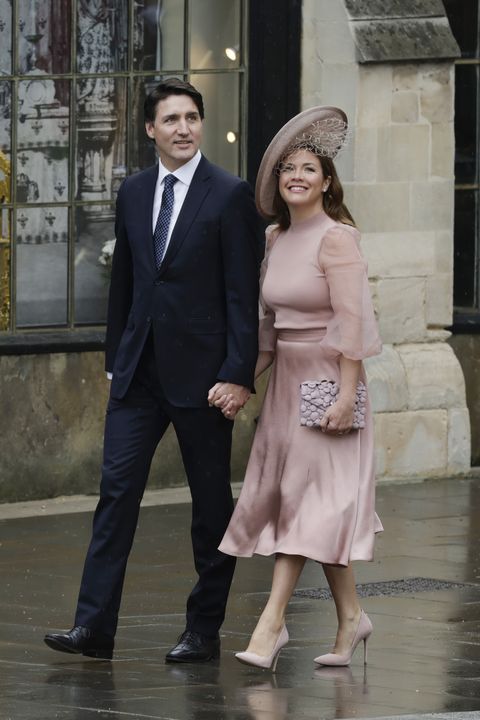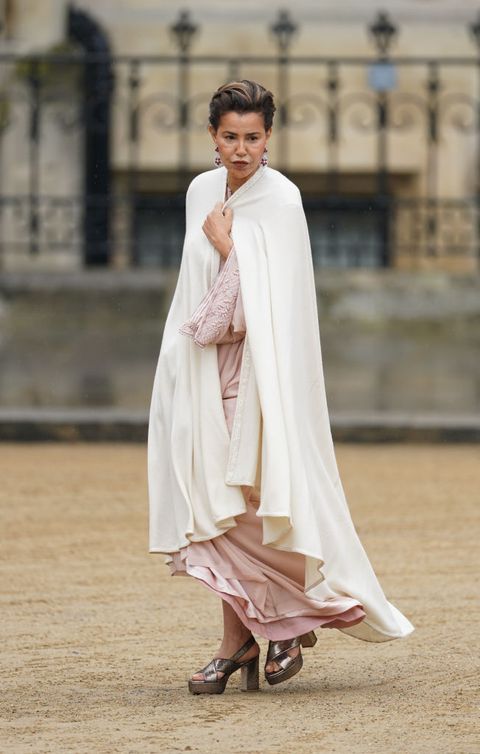King Charles III was crowned Saturday at Westminster Abbey, in a ceremony steeped in ancient ritual and brimming with bling at a time when the monarchy is striving to remain relevant in a fractured modern Britain.
At a coronation with displays of royal power straight out of the Middle Ages, Charles was given an orb, a sword, and a scepter and had the solid gold, bejeweled St. Edward’s Crown placed atop his head as he sat upon a 700-year-old oak chair.
In front of world leaders, foreign royals, dignitaries, and a smattering of stars, the monarch declared, “I come not to be served but to serve,” and was presented as Britain’s “undoubted king.”
Inside the medieval abbey, trumpets sounded, and the congregation of more than 2,000 shouted “God save the king!” Outside, thousands of troops, hundreds of thousands of spectators, and scores of protesters converged.
It was the culmination of a seven-decade journey for the king from heir to monarch.
To the royal family and government, the occasion — code-named Operation Golden Orb — was a display of heritage, tradition and spectacle unmatched around the world.
To the crowds gathered under rainy skies — thousands of whom had camped overnight — it was a chance to be part of a historic event.
Julie Newman, a 77-year-old visitor from Canada, said the royal procession had been “absolutely fabulous. Couldn’t ask for anything better.”
“But we’re ready to go back home and watch it all on the television,” she added.
But to millions more, the day was greeted with a shrug, the awe, and reverence the ceremony was designed to evoke largely gone.
And to a few, it was a reason to protest. Hundreds who want to see Britain become a republic gathered to holler “ Not my king.” They see the monarchy as an institution that stands for privilege and inequality, in a country of deepening poverty and fraying social ties. A handful were arrested.
As the day began, the abbey buzzed with excitement and was abloom with fragrant flowers and colorful hats. Notables streamed in: U.S. first lady Jill Biden, first lady Olena Zelenska of Ukraine, French President Emmanuel Macron, eight current and former British prime ministers, judges in wigs, soldiers with gleaming medals, and celebrities including Judi Dench, Emma Thompson, and Lionel Richie.
During the traditional Anglican service slightly tweaked for modern times, Charles, clad in crimson and cream velvet and ermine-trimmed robes, swore on a Bible that he is a “true Protestant.”
But a preface was added to the coronation oath to say the Anglican church “will seek to foster an environment where people of all faiths and beliefs may live freely.” It was the first ceremony to include representatives of the Buddhist, Hindu, Jewish, Muslim, and Sikh faiths, as well as the first in which female clergy took part.
Charles was anointed with oil from the Mount of Olives in the Holy Land — a part of the ceremony so sacred it was concealed behind screens — before being presented with the Sovereign’s Orb and other regalia.
Archbishop of Canterbury Justin Welby then placed the crown on Charles’ head, while he sat in the Coronation Chair — once gilded, now worn and etched with graffiti. Underneath the seat was a sacred slab known as the Stone of Scone, on which ancient Scottish kings were crowned.
For 1,000 years and more, such grandiose ceremonies have confirmed the right of British kings to rule. Charles was the 40th sovereign to be enthroned in the abbey — and, at 74, the oldest.
These days, the king no longer has executive or political power, and the service is purely ceremonial since Charles automatically became king upon the death of his mother, Queen Elizabeth II, in September.
The king does remain the U.K.’s head of state and a symbol of national identity — and Charles will have to work to bring together a multicultural nation and shore up support for the monarchy at at time when it is waning, especially among younger people.
While most Britons view the monarchy on a spectrum ranging from apathy to mild interest, some are fervently opposed to it. The anti-monarchy group Republic said several of its members, including its chief executive, were arrested as they arrived at a protest in central London.
Police, who’d warned they would have a “low tolerance” for people seeking to disrupt the day, said they made 52 arrests. Human Rights Watch said arrests of peaceful protesters were “something you would expect to see in Moscow, not London.”
The multimillion-pound cost of all the pomp — the exact figure unknown — also rankled some amid a cost-of-living crisis that has meant many Britons are struggling to pay energy bills and buy food.
Charles has sought to lead a smaller, less expensive royal machine for the 21st century, and he was a shorter, smaller affair than his mother’s coronation.
The notoriously feuding royal family put on its own show of unity. Prince William, who is next in line to be king, his wife, Kate, and their three children were all in attendance. Towards the end of the ceremony, William knelt before his father and pledged loyalty to the king — before kissing him on the cheek.
Then Archbishop Welby invited everyone in the abbey to swear “true allegiance” to the monarch. He said people watching on television could pay homage, too — though that part of the ceremony was toned down after some criticized it as a tone-deaf effort to demand a public oath of allegiance for Charles.
William’s younger brother Prince Harry, who has publicly sparred with the family, arrived alone. His wife Meghan and their children remained at home in California, where the couple has lived since quitting as working royals in 2020.
As Charles and the key royals joined a magnificent military procession after the ceremony, Harry stood waiting outside the abbey until a car arrived to drive him away.
Large crowds cheered as Charles and Queen Camilla, who was also crowned, rode in the Gold State Carriage from the abbey to Buckingham Palace, accompanied by a procession of 4,000 troops and military bands playing jaunty tunes. From the palace balcony, the king and queen waved to a sea of people who cheered and shouted “God Save the king!”
For many other Britons, the day’s events drew mild curiosity, at best.
Cherie Duffy, who was visiting London from Anglesey, Wales, on a trip planned before the coronation date was set, watched the ceremony on TV — but only because someone else turned it on.
“There’s a general not-bothered ness,” she said about how she and her friends felt.
American pop star Katy Perry will perform during King Charles’ coronation ceremony Saturday, the first for the United Kingdom in 70 years, after the Grammy Award-nominated artist—one of two Americans, and virtually no major U.K. stars, performing at the event—was asked by Charles to appear.
KEY FACTS
Perry was announced alongside Lionel Richie, the British pop group Take That, opera stars Andrea Bocelli and Bryn Terfel, Freya Ridings, and Alexis Ffrench as performers for a coronation concert on May 7, according to the BBC.
Charles and Perry first met during an event in Mumbai in 2019, before Charles appointed Perry as an ambassador for the British Asian Trust a year later.
Charles said Perry was appointed to the charity because she has a “long-standing commitment to charitable causes around the world”—though some criticized the decision because Perry is neither British nor Asian.
Perry referred to her friendship with Charles during her introduction to the charity—founded by Charles in 2007—and said Charles was a “very kind soul,” adding he had asked her if she “could sing to his plants.”
After being announced as a performer for Charles’ coronation, Perry suggested her performance would help “shine a further light on the British Asian Trust’s Children Protection Fund.”
Richie, a Grammy- and Oscar-winning singer, is also connected to Charles: He was appointed by the former Prince of Wales as the first global ambassador for The Prince’s Trust, a charity founded by Charles in 1976.
Perry told Extra she will be staying at Windsor Castle prior to Saturday’s events, adding she will be posting “a lot” of images of the castle to social media.
BIG NUMBER
$25 million. That’s how much Perry is earning per season of American Idol, adding to her estimated net worth of $38.5 million.
Several British performers have declined invitations to perform at the coronation, with much speculation that they wanted to avoid being associated with recent Buckingham Palace scandals, from the alleged mistreatment of Prince Harry and Meghan Markle to Prince Andrew’s alleged sexual relationship with one of the late U.S. financier Jeffrey Epstein’s trafficking victims. Elton John—who was close with Charles’ late ex-wife, Princess Diana—declined, blaming scheduling conflicts. The Spice Girls denied rumors of a reunion at the event, indicating the group would not have enough time to rehearse beforehand. Ed Sheeran—who recently appeared in Manhattan federal court over plagiarism allegations—declined an invitation also because of scheduling conflicts. Adele, who was named a Member of the Most Excellent Order of the British Empire by Charles in 2013, and Harry Styles also declined to perform.
King Charles will be crowned Saturday during the United Kingdom’s traditional coronation ceremony, eight months after he ascended to the throne following Queen Elizabeth II’s death. The event will include an estimated 2,000 guests and will feature a number of historical relics. The coronation—the first in the social media age—will also feature an emoji modeled after St. Edward’s Crown. Perry, a 13-time Grammy Award-nominated pop star, was noted by Charles and the royal family for her charity work, specifically her time as a global ambassador for UNICEF.
Queen Camilla has been crowned at Westminster Abbey, following a similar ceremony involving King Charles III, as thousands of church guests and millions of watchers around Britain and the world witnessed his coronation, the biggest ceremonial event the nation has put on in 70 years.
Queen Camilla was anointed in public view, the first time the moment has been televised, and received the Queen’s Consort’s Rod with Dove—an ivory scepter steeped in controversy because of the UK’s ban on ivory last year, in addition to Prince William’s criticism of the ivory trade.
Charles took two oaths—the Coronation Oath and Accession Declaration Oath—in which he pledged his faith and promised to uphold the law, before the Archbishop of Canterbury delivered a sermon before the new king was shielded from public view as a choir sang Handel’s “Zadok the Priest,” a cinematic moment ahead of Charles’ anointing.
Charles and his wife, Queen Camilla (whose “Consort” title has now been dropped), were greeted by fanfare and the Abbey’s ringing bells as they arrived to the ceremony.
The monarchs, both in ceremonial dress, waved to the crowds during an opulent procession along the Mall lined by thousands of supporters—the scene will be familiar to viewers who witnessed the procession of Queen Elizabeth II’s funeral eight months ago.
Central London was blanketed by distinctly British gray clouds and a light drizzle as Charles’ procession from Buckingham Palace to the Abbey got underway.
Thousands of guests, including Prince Harry and other members of the royal family, foreign presidents, and charity workers, awaited the new monarch in the Abbey, which has been the site of coronations for nearly 1,000 years.
Faith leaders representing communities across Britain—including Christian, Muslim, Jewish, Sikh, and Buddhist—are also in attendance, a historic move that represents Charles’ desire to make the British monarch’s job as “defender of the faith” more inclusive.
Police arrested several anti-monarchy demonstrators in Trafalgar Square on Saturday morning, part of the Republic campaign group protesting the ceremony’s reported cost—estimates vary, but the BBC puts it at up to $126 million (£100 million)—and calling for a public vote on the future of the monarchy.
KEY BACKGROUND:
Saturday’s ceremony caps off months of preparation and anticipation over how Charles would mark his day. His coronation is relatively scaled back compared with his mother’s: as well as fewer guests, his procession to the Abbey was shorter, while the ceremony featured a gospel choir. But it also reflects the causes Charles has championed while in waiting—and the type of monarch he hopes to be. As well as the expansion of the “defender of the faiths” role, Charles’ environmental campaigning is being marked by the U.K. government creating new woodland and committing funding to tree planting in honor of the coronation. Guests from more than 200 countries attended Saturday’s ceremony, which was more diverse than previous coronations. As the first coronation of the social media age, the Royal Family's Twitter account posted updates of the event all morning. Yet, the tradition remained front and center, with Charles being crowned with the priceless St Edward’s Crown, which dates back more than 360 years, along with other long-established elements of coronations dating back to 1066.
2,000. That’s how many guests—including Royal Family members, world leaders, royals from around the world, and ambassadors of charities handpicked by the British royals—will attend the ceremony at Westminster Abbey. That’s about a quarter the number of guests who watched Queen Elizabeth II’s coronation. Today’s guest list had been a source of great speculation, particularly as to whether Prince Harry would attend. He is but without his wife Meghan Markle and his children. Thousands more royal supporters from across the world are expected to line the streets around central London.
CONTRA
Despite the overwhelming coverage, Union Jack bunting lining the streets and party preparation across Britain, many are apathetic. The extravagance of the event stands in sharp contrast to a backdrop of high inflation, rising household bills, and a cost of living crisis. Around 60% of Britons support the monarchy’s future, while a quarter want an elected head of state, according to a recent YouGov poll. A plurality (35%) of people polled by YouGov last month said they cared “not very much” about the coronation. Anti-monarchy protests are taking place in Trafalgar Square, less than a mile from Westminster Abbey.
Has there ever been such a fashionable first week of May? The answer is likely no, given the killer combo of the 2023 Met Gala earlier this week and King Charles III's coronation today. While the latter might not scream "STYLE" as obviously as the Met's big night out, the British royals still showed out in sweeping capes, intricate headpieces, and (of course) crowns.

Article content
In the fairy-tale ending to the ancient pageantry in which King Charles Ill has crowned monarch, he stepped into a gilded horse-drawn carriage with his queen and rode off to his palace.
Advertisement 2
Article content
Following closely behind was Prince William, his eldest son and heir, along with his family, including 9-year-old Prince George who is second in line to the throne.
The king’s youngest son was nowhere to be seen. On his father’s biggest day, Prince Harry arrived at Westminster Abbey alone and he left alone. The disgruntled Duke of Sussex was assigned to sit two rows behind his brother.
The royals' ceremonial fashion choices have a deeper meaning, down to the minute details. Princess of Wales Kate Middleton wore an ivory dress by Alexander McQueen and also donned matching robes with her husband Prince William at the special request of King Charles and Queen Camilla. Notably, she and her daughter Princess Charlotte did not wear tiaras, instead donning matching floral headpieces.
For more coronation fashion, enjoy the photos below.

















































